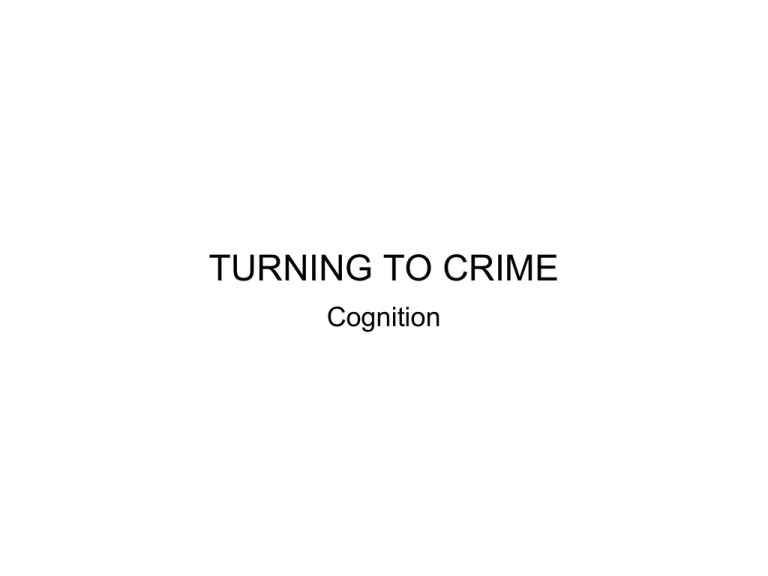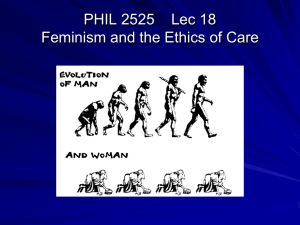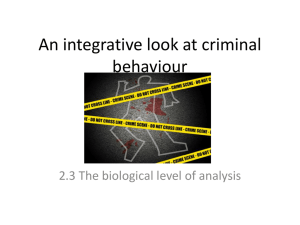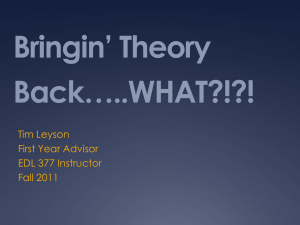Turning to Crime Cognitive
advertisement

TURNING TO CRIME Cognition Turning To Crime Cognition Criminal Thinking Patterns Moral Development Attribution of Blame Yochelson & Samenow Kholberg/Chen Gudjohnsson Cognition: Criminal Thinking Patterns • • • • Another influence that can explain why an individual turns to crime is the way they think. Psychologists apply the term ‘cognition’ to mental processes that determine our actions, feelings and beliefs. The basic assumption is that there must be a difference between the way a law-abiding person thinks and the way a criminal thinks. Cognitive psychological research has been directed at moral development, patterns of thinking and the sorts of attributions criminals make about their actions. What are the limitations to this explanation of crime? Free Will vs Determinism • How far are cognitive factors under the control of the individual (free will) or are they predetermined by other factors (determinism) when someone has committed a crime? For the most part we take responsibility for our guilt, however when some offenders are viewed mentally unstable they may make a ‘plea of diminished responsibility (behaviour the outcome of lost sanity, which maybe temporary).’ The rules a court uses to decide whether to uphold the plea are the McNaghten Rules and in the event the plea is upheld usually indefinite imprisonment is the consequence. In order for an offender to be found guilty and sentenced they need to be of Mens Rea, ‘guilty mind’ and Actus Reus, ‘guilty act.’ Evidence 1: Yochelson & Samenow Cognitive psychologists believe that it is possible to discover a thought process just by interviewing a person and asking them what they are thinking in a particular situation. Evidence 1: Evaluating Yochelson & Samenow’s research into explanations of criminal behaviour • • • • • Methodology: Advantages: Disadvantages: _______________________________________________________ _ Sample: What is the problem with the sample? Evidence 1: Evaluating Yochelson & Samenow’s research into explanations of criminal behaviour • • • • • ISSUES: The other weakness of this research is the lack of a control group. Why does this matter? Type of data collected: Advantages: Disadvantages: Evidence 1: Evaluating Yochelson & Samenow’s research into explanations of criminal behaviour • • • ISSUES Type of design: Advantages: • Disadvantages: • Comment on the ethics of the study: Evidence 1: Evaluating Yochelson & Samenow’s research into explanations of criminal behaviour • • • PERSPECTIVES & APPROACHES How does this study link in with the psychodynamic perspective? How does this study link in with the cognitive approach? Evidence 1: Evaluating Yochelson & Samenow’s research into explanations of criminal behaviour • • • DEBATES How does this study link in with determinism/free will? How does this study link in with the nature/nurture debate? Cognition: Moral Development • • • If a person behaves in a moral way then they can be said to be adhering to conventionally accepted standards of behaviour. In other words they follow the norms and values of society, and the laws which support these. Morals distinguish the good and bad behaviour, or right and wrong. • It is believed in the UK that by the age of 10, children clearly know the difference between right and wrong and therefore the criminal justice system sets the age of criminal responsibility at this point. • This means that a child of 10 can be sentenced to imprisonment in a young offenders’ institution. Evidence 2: Kohlberg - Moral development & Crime • • • Morals are a set of norms and values, usually learnt from our parents about what is right and wrong. Kohlberg (1963) was heavily influenced by the work of Piaget and believed that children’s cognition developed through stages. His research involved presenting boys with moral dilemmas and then asking them questions about them. Kohlberg’s research and the work it has generated helped to answer the following questions: • • • Are there different stages of moral reasoning where the reasons for acting morally, that is doing the right thing, differ between the stages? Does the development of these stages occur over time? If someone has an immature level of moral development for their age does this make them more likely to commit a crime? Evidence 2: Kohlberg - Moral development & Crime • • • • • • • • Heinz Dilemma Heinz’s wide was suffering from terminal cancer. In an effort to save her he went to a chemist who had developed a cure which might help her. Unfortunately, the chemist wanted much more money for his cure than Heinz could afford and refused to sell it for less. Even when Heinz borrowed enough money for half the cost of the drug, the chemist still refused to sell it to them. Having no other means of getting the drug, Heinz broke into the chemist’s laboratory and stole it. Should he have broken into the laboratory? Why? Should the chemist insist on the inflated price for his invention? Does he have the right? What should happen to Heinz? What if Heinz did not love his wife - does that change anything? What if the dying person was a stranger? Should Heinz have stolen the drug anyway? • • • Kohlberg’s theory of Moral Development Kohlberg believed, as did Piaget, that moral development depending very much on cognitive development. But Kohlberg believed that moral development continued beyond the age of 11 and 12 years. He explored the moral thinking of boys aged between 10, 13 and 16 years of age by asking them about moral dilemmas in which they had to choose between either obeying the law or disobeying in order to serve human need. Kohlberg’s theory of moral development • From these intensive clinical interviews, Kohlberg deduced his stages of moral development. Kohlberg’s stages of moral development Pre-conventional Punishment and obedience orientation Reward orientation Conventional Good boy/nice Girl orientation Law and order orientation Post-conventional Social contract, legalistic orientation Universal ethical principles Evidence 2: Evaluating Kohlberg’s research into explanations of criminal behaviour • What are the problems with Kohlberg’s sample? • Is the research ethnocentric? • Are dilemmas an appropriate way of measuring morality? Evidence 2: Evaluating Kohlberg’s research into explanations of criminal behaviour • • • • What are the strengths of Kohlberg’s research? What method was used in Kohlberg’s study? What are the strengths of this method? What are the weaknesses of this method? Evidence 2: Evaluating Kohlberg’s research into explanations of criminal behaviour • • • • • • APPROACHES How is the study linked to the developmental approach? How is the study linked to the cognitive approach? DEBATES How is the study linked to the nature/nurture debate? How is the study linked to determinism/free will debate? Chen and Howitt Cognition: Attribution of Blame: Social Cognition • • • • This area of psychology refers to how our thoughts are influenced by the people we interact with but also how we can understand social phenomena by looking at an individual’s cognitions. Studies in this area are interested in looking at the perception of the social situation, the judgement of the individual and memory for social stimuli. This helps us to understand intrapersonal, interpersonal and intergroup processes. In the context of the criminal and crime, the social context is the criminal act, so it is helpful to try and find out what a criminal is thinking when they commit the crime. It is important for us to understand the social cognitions of the criminal for crime prevention purposes. • • • • We all justify our behaviours using either internal or external attributions. An internal attribution is when a person accepts full responsibility for their own behaviour and sees the cause as being within themselves. An external attribution is when a person sees the cause of their behaviour as being an external factor, e.g. ‘I was provoked, it’s his fault I hit him’, ‘I had a bad childhood’, ‘I’ve got no money, job etc.’ A criminal is considered rehabilitated when they can fully accept responsibility for their crime, in other words have an internal attribution, they accept their guilt. Evidence 3: Evaluating Gudjohnnson’s research into explanations of criminal behaviour • Why do we need to know how offenders attribute blame? • Why would we need to be cautious about the findings of an inventory? • Can the sample be generalised? • What is the benefit of gaining understanding of the criminal thought process? Evidence 3: Evaluating Gudjohnnson’s research into explanations of criminal behaviour • How is the study linked to situational/individual explanations of behaviour? • How is this study linked to the cognitive approach? • How is this study linked to the social approach?









